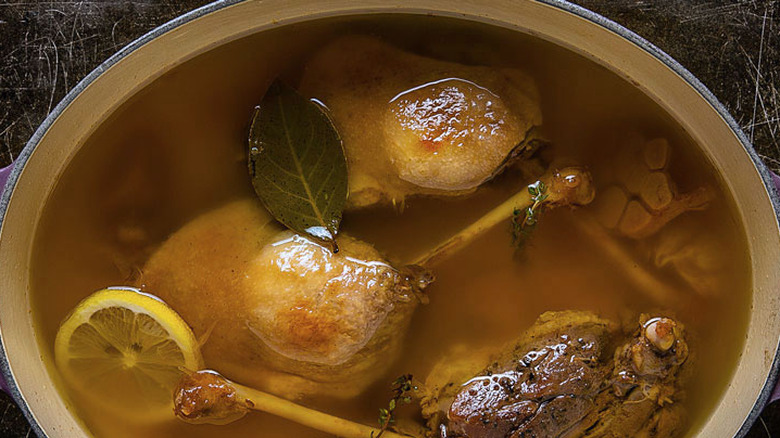How To Make Duck Confit | Tasting Table Recipe
Duck confit is a centuries-old French dish that consists of a two-method preservation process: To get technical about it, the first part involves salt-curing the meat, which removes any moisture from the meat that could contain microorganisms. Next, you cook and store the meat in its own fat so no air can get trapped.
But what results is downright delicious: fall-off-the-bone meat that's just as good on its own as it is shredded. We like to make it into rillettes or add it to a pot of stewed beans, but the possibilities are endless.
To learn more, read "This Recipe Has Legs."
Recipe from the Tasting Table Test Kitchen
Duck Confit
Learn to make duck confit at home.
Prep Time
30
minutes
Cook Time
3.33
hours
Servings
4
servings

Total time: 3 hours, 50 minutes
Ingredients
- 3 tablespoons salt
- 1 teaspoon whole juniper berries, toasted and ground in a spice mill
- 4 skin-on bone-in duck legs, Frenched (see note)
- 6 cups duck fat
- 4 sprigs thyme
- 2 ¼-inch round slices of lemon
- 2 fresh bay leaves
- 1 head garlic, split in half horizontally
Directions
- In a small bowl, combine the salt and juniper. Place the duck legs on a parchment-lined sheet tray and season liberally with the juniper salt. Cover with plastic wrap and chill overnight or for up to two days.
- Remove the duck legs from the refrigerator and rinse and pat dry. Using a paring knife, make small pricks all over the skin. Melt the duck fat in an 8-quart Dutch oven or heavy-bottomed pot over medium heat until a deep-fry thermometer reads 200°. Add the duck legs, thyme, lemon, bay leaves and garlic and cook, maintaining a temperature of 190° to 210°, until the duck legs are very tender and there is no resistance when pulling the bones, about 2 to 2½ hours.
- Carefully remove the duck legs and set aside. Strain the duck fat through a fine-mesh sieve into a large bowl, leaving any cloudy liquid behind. Place the duck legs in a 4-quart Pyrex dish; pour the strained fat over the top until it covers the legs by 1 inch; cover and chill. The duck legs can be used right away or stored for up to a month. (Refrigerate the duck fat for other uses, such as frying potatoes or sautéing greens.) 4. To serve, heat the oven to 400°. Remove the duck from its storing liquid and place skin-side up on an aluminum-lined sheet tray over a wire rack. Cook until golden brown and crisp, about 30 to 35 minutes. Serve with garlicky potatoes or with slow-cooked beans. Note: To French the duck legs, use a paring knife to cut around the skin on the drumstick about 1 inch below the tip of the bone. Scrape down toward the meat to expose the bone. Discard any excess skin or meat.